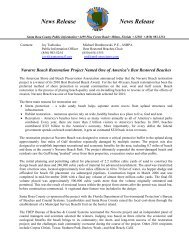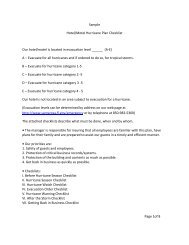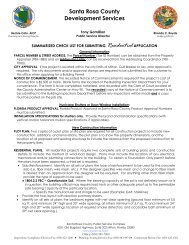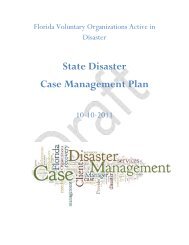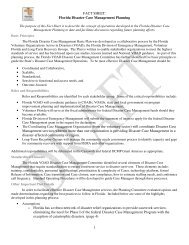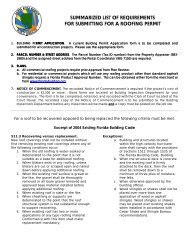Disaster - Santa Rosa County
Disaster - Santa Rosa County
Disaster - Santa Rosa County
You also want an ePaper? Increase the reach of your titles
YUMPU automatically turns print PDFs into web optimized ePapers that Google loves.
Generator Safety<br />
Having a portable generator can make the days after a storm much more bearable. However,<br />
they can be hazardous. Generator safety and proper handling is imperative for everyone<br />
who operates one. Because it runs on gas, (which can cause carbon monoxide poisoning)<br />
always remember to never operate a generator indoors, whether it’s in your home, garage,<br />
basement, or other enclosed or partially enclosed areas. Carbon monoxide is a colorless,<br />
odorless gas that can be deadly. It is also important not to install the generator beside your<br />
home, or in your garage or carport because the carbon monoxide can accumulate in the<br />
attic or extra roof space of your home. Be sure to keep the generator dry. Only operate it<br />
on a dry surface under an open, canopy-like structure. Before touching the generator make<br />
sure your hands are dry.<br />
22<br />
Generator Safety<br />
Before refilling the gas tank, turn it off and let it cool. It should not be refilled while the generator is running. Fuel spilled<br />
on hot engine parts could ignite and cause a fire. Check your oil every time you re-fuel and store any extra fuel away from any<br />
fuel-burning appliances.<br />
Plug appliances directly into a generator starting with the largest electric appliance first;<br />
then plug in other items, one at a time or use a heavy-duty, outdoor-rated extension cord.<br />
Make sure the entire extension cord is free of cuts or tears and the plug has all three prongs,<br />
especially a grounding pin. Grounding the generator is recommended to help prevent<br />
accidental electrical shock. NEVER plug the generator into a wall outlet. The only safe<br />
way to connect a generator to house wiring is to have a qualified electrician install a power<br />
transfer switch.<br />
A generator is something everyone should keep in their home or workplace in case of a<br />
disaster. It can keep the lights and fans running as well as other important necessities such<br />
as refrigerators, freezers, microwaves, stoves, security alarm systems, garage door openers,<br />
air conditioners, washer and dryers, televisions and DVD players, gaming equipment and<br />
computers. After a disaster, a generator can be used to run your outdoor power equipment<br />
when cleanup is needed. There are two types of generators to consider, portable and<br />
standby.<br />
Items you will Need to Operate a Generator<br />
CO Detector<br />
This will protect you from any possible exposure to carbon<br />
monoxide fumes while the portable generator is in use. The price<br />
range starts at about $20 to protect different rooms in your home.<br />
Gas Cans<br />
It is a good idea to have some extra gas cans so you don’t run out of gas for your generator.<br />
Inverters<br />
With this continuous source of backup power, you are able to maintain power to your home from your car.<br />
Extension Cords<br />
You should always have these in your home because they can be used for a<br />
wide variety of household operations. Heavy duty 12 or 14-gauge grounded<br />
(3-prong) or GFCI cords work great with the operation of a generator.<br />
Fuel Stabilizers & Lubricants<br />
The stabilizer is used to prevent stale gas from forming due to a long storage period. It is best to<br />
change the oil after the first five hours of operation, then after every 50 hours of use.<br />
Standby<br />
or a Portable<br />
Generator<br />
Standby generators are<br />
for people who experience<br />
long power outages or have<br />
special requirements for<br />
continuous power. These<br />
can provide anywhere<br />
from 10 to 30 kilowatts.<br />
Portable generators can<br />
be easily stored and<br />
start around $350. They<br />
run off a gasoline engine<br />
and can power a limited<br />
amount of appliances<br />
using extension cords.<br />
These types of generators<br />
provide 2 to 8 kilowatts,<br />
which is about 8 to 12<br />
hours of power.





